5 Ways to Preserve Peaches – Plus the Easiest Way to Peel Peaches
Each year I preserve peaches in a variety of ways, stashing some for us to enjoy and some to use as gifts. In this post I'll cover the easiest way to peel peaches, as well as canning, dehydrating, freezing, peach jam and freeze drying peaches.
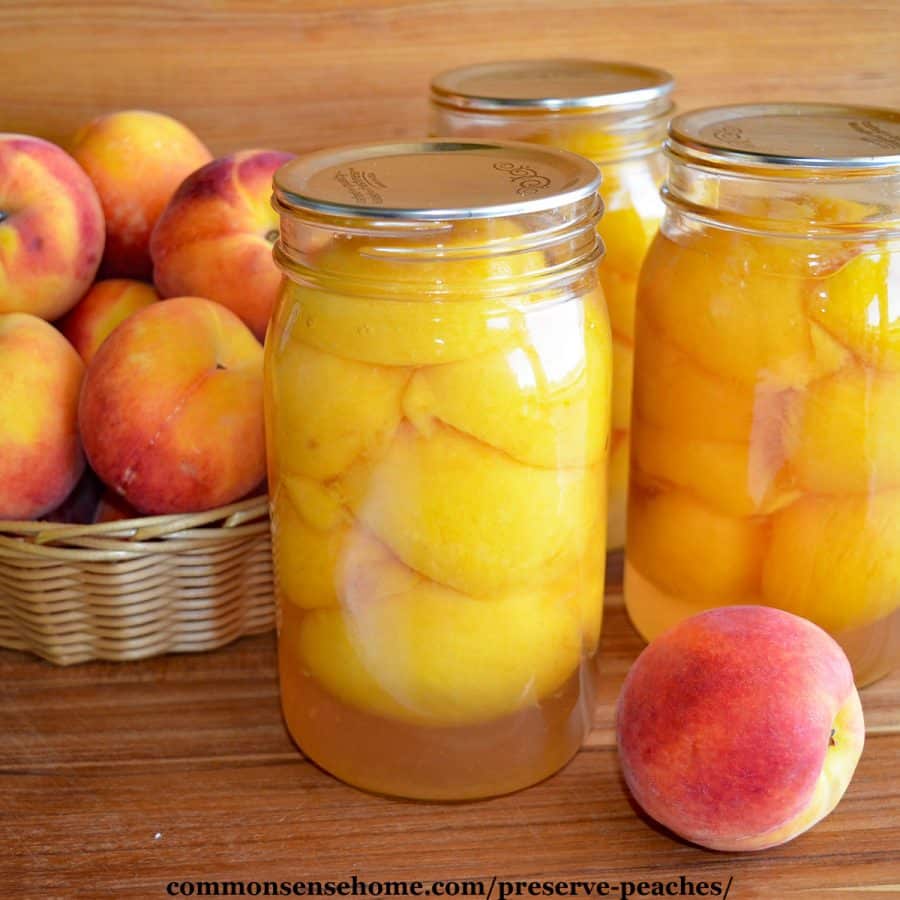
My youngest loves peaches, so we stock up every year. We're still working on trying to get peach trees to survive as part of our permaculture food forest. We're right at the edge of peach friendly territory, but our place gets a lot of wind, which the trees don't like very much.
Which peaches are best for which use?
For canning and freeze drying peaches, use those that are ripe but still firm. Softer peaches are better for jam or dehydrating. Clingstone peaches (where the flesh sticks to the pit) are easier to use for jam, because it's tough to get clean slices.
Once the skins are off your peaches, you need to work fast. Even with lemon water or commercial anti-browning products, the clock is ticking as soon as the skins come off.
I prep my preserving equipment before I start peeling. That way, the peaches can go immediately into the canner, dehydrator or freeze dryer as soon as the skins are off.
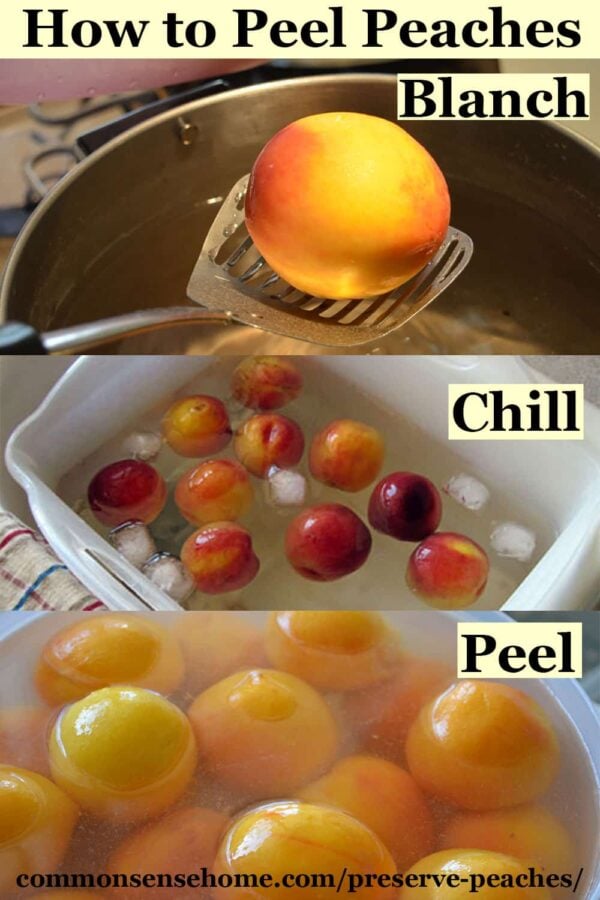
The Easiest Way to Peel Peaches
Before canning, drying or freeze drying peaches, I remove the skins. I highly recommend this step. The skins get really chewy after drying, and strangely slimy after canning. You can use a knife or peeler to remove the skins, but blanching is much easier.
What you need to blanch/peel peaches:
- Large pot of boiling water
- Slotted spoon or other large scoop to remove the peaches from the boiling water
- Bowl to move the peaches from the stove to the cold water
- Large basin of cold water/ice water to stop the blanching
- Peaches
- Large bowl with acidified water for peeled peaches (Adding acid to the water helps to prevent browning. To make acidified water, add roughly 2 tablespoons lemon juice (or 1 teaspoon citric acid) to about one gallon of water)
To peel the peaches:
- Bring water to rolling boil.
- Place 6-8 peaches in water (depending on pot size).
- Keep peaches in boiling water for one minute.
- Remove peaches from boiling water. Place peaches in chilled water until cool enough to handle.
- Slip off skins and place peaches in acidified water.
- Repeat until all peaches are done, then proceed with additional processing.
When blanching, you want to work quickly, so no peach is in too long. Too much time in the pot and they will cook and get soft.
Similarly, once skinned and in the acidified water, they will absorb water and get soft and brown. If you're processing a lot of peaches, get help if you can, or work in small batches.
I demonstrate how to remove peach skins via blanching in the video below. (Make sure your ad blocker is off for video to display.)
Put child labor to work peeling peaches if you have lots of peaches.

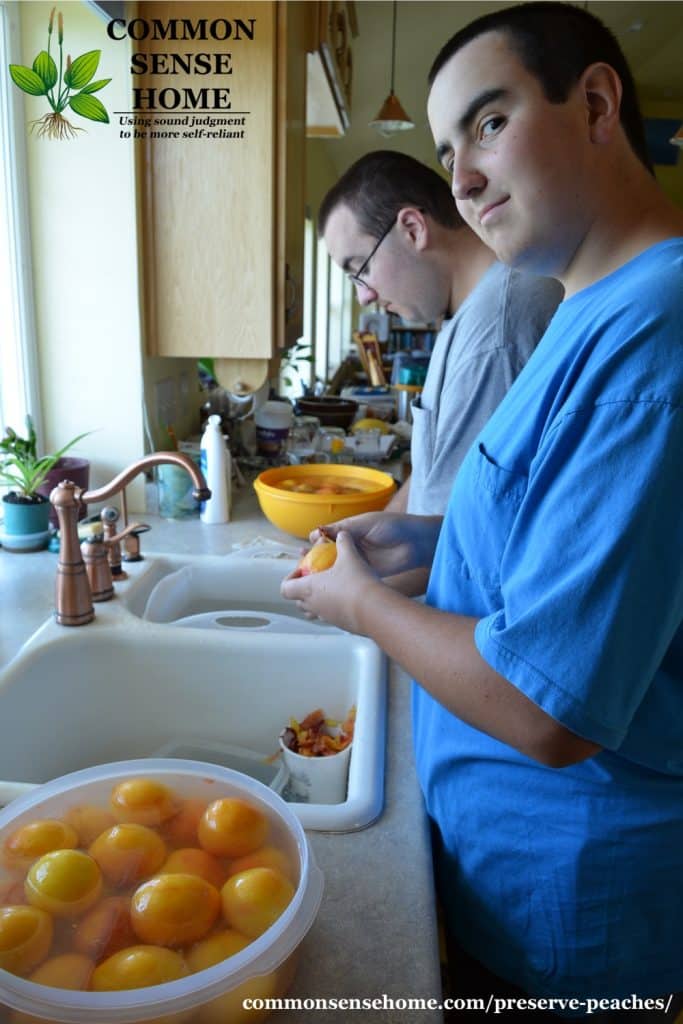
I usually let the boys finish peeling while I prep everything else for canning.
I remove the pits and either half or quarter the peaches, depending on the jar size (I use wide mouth quart jars for peach halves) and make sure the cut edges are exposed to the lemon water to prevent browning.
Preserve Peaches – Canning – Cold Pack Method
I prefer to cold pack peaches, which means the fruit is loaded in the jars at room temperature and then boiling syrup is poured over the top. I think the peaches stay firmer and more attractive using this method, even though they float more in the jar.
Canning Equipment You Will Need:
- hot water bath canner
- clean and sterilized quart jars (I run mine through the dishwasher and time it so they are hot when I'm ready to can)
- lids and rings in hot (not boiling) water
- jar lifter
- tongs or lid lifter to grab rings
- funnel
- clean cloth to wipe jar rims
- ladle
- wooden spoon for stirring
- chopstick to remove air bubbles
- Light syrup (recipe below)
I like to work from left to right on my stove. Fill on the left side, process center, unload finished jars on a waiting cloth next to the right side of the stove.
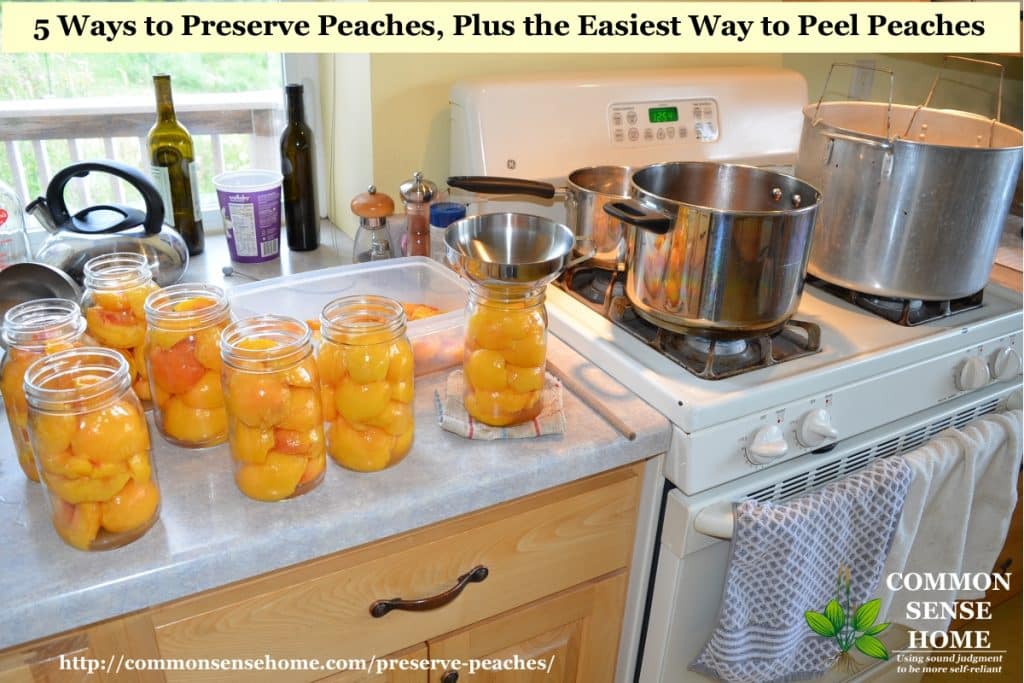
Light Sugar Syrup Recipe
Ingredients
- 2 1/2 cup sugar
- 5 1/4 cups water
Directions
To prepare syrup, while heating water, add sugar slowly, stirring constantly to dissolve. Bring to a gentle boil.
Sugar acts as a preservative by binding up free water in the fruit (see The Natural Canning Resource Book).
You may use less sugar, substitute honey for the sugar, or can in fruit juice. Using less sugar will give your product a shorter shelf life and quicker discoloration.
I have found that the light simple syrup proportions strike a good balance between extending storage time and not being too sweet.
Note: The juice from the peaches also makes a great flavoring for homemade water kefir.
To Can the Peaches
Plan for 2 to 3 pounds of peaches per quart. Peel and slice the peaches as directed above.
Drain peaches in a colander to drain excess liquid. Fill jars with peach slices to 1/2 inch headspace. Ladle on hot syrup.
Run your chopstick or small non-metallic spatula between the peaches and the jar to remove air bubbles. (Metal may scratch the inside of the jar).
Add extra syrup if needed to have fruit and syrup level 1/2 inch from lid. Wipe rim clean, screw on lid (not too tight – air must escape during processing).
Place jars on rack in canner. When canner is full, lower jars into water. Make sure jars are covered by 1-2 inches of water. Bring to boil, process (boil gently) – pints 20 minutes, quarts 25 minutes.
When the cooking time is up, remove jars and place on a towel away from heat and any drafts.
After 12-24 hours, check lids for seal. Standard lids should be concave in the center and held down tightly. I love listening to the “ping” as the jars seal!
For long term storage, remove rings, wipe up any spills. Label and date (I write on the lids with a Sharpie marker).
Store in a cool, dry location out of direct sunlight for best shelf life. (See top photo for finished peaches.)
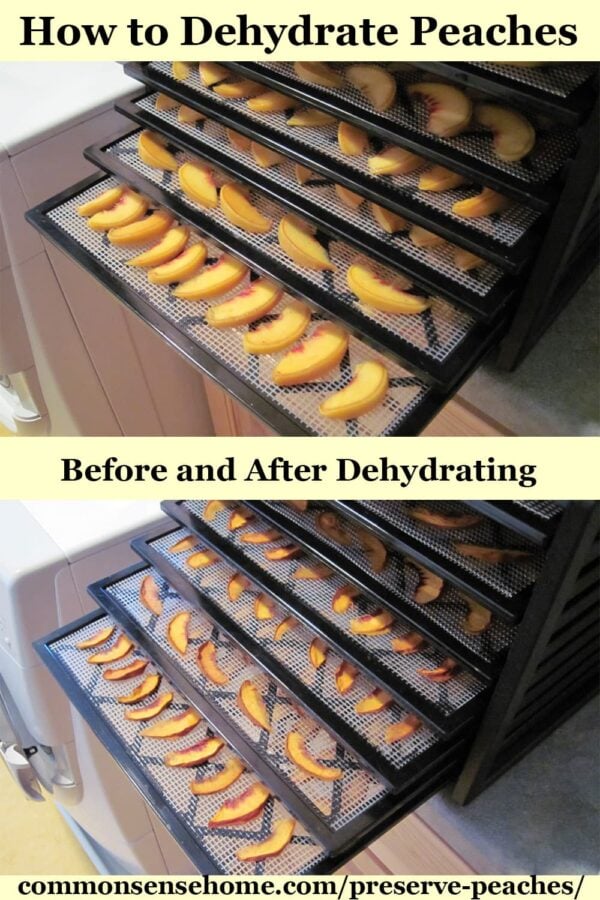
Drying Peaches in a Dehydrator – One of the Simplest Ways to Preserve Peaches
Dehydrating is an easy way to preserve peaches. I dry whatever I can't easily fit in the canner, or peaches that are too soft to can or bruised.
You can also dry whole peach halves with the skin on (like commercial dried peaches), but they take much longer to dehydrate.
These peach slices dehydrate overnight. The finished slices are light and slightly chewy, not gummy like peach halves.
To Dehydrate Peaches:
- Thinly slice your peeled peaches
- Dip peach slices in the lemon water to prevent browning (optional)
- Drain the slices in a strainer
- Place peach slices on a dehydrator tray or a mesh insert
- Dry at around 135-140 °F until leathery or crisp (about 8-12 hours), depending on thickness of slices. I usually dry mine overnight.
I highly recommend using the mesh inserts (default option for the Excalibur, optional in the Snackmaster). The peaches are very sticky and are hard to remove from the trays without the inserts. With the inserts, you just bend them and the dried fruit pops right off.
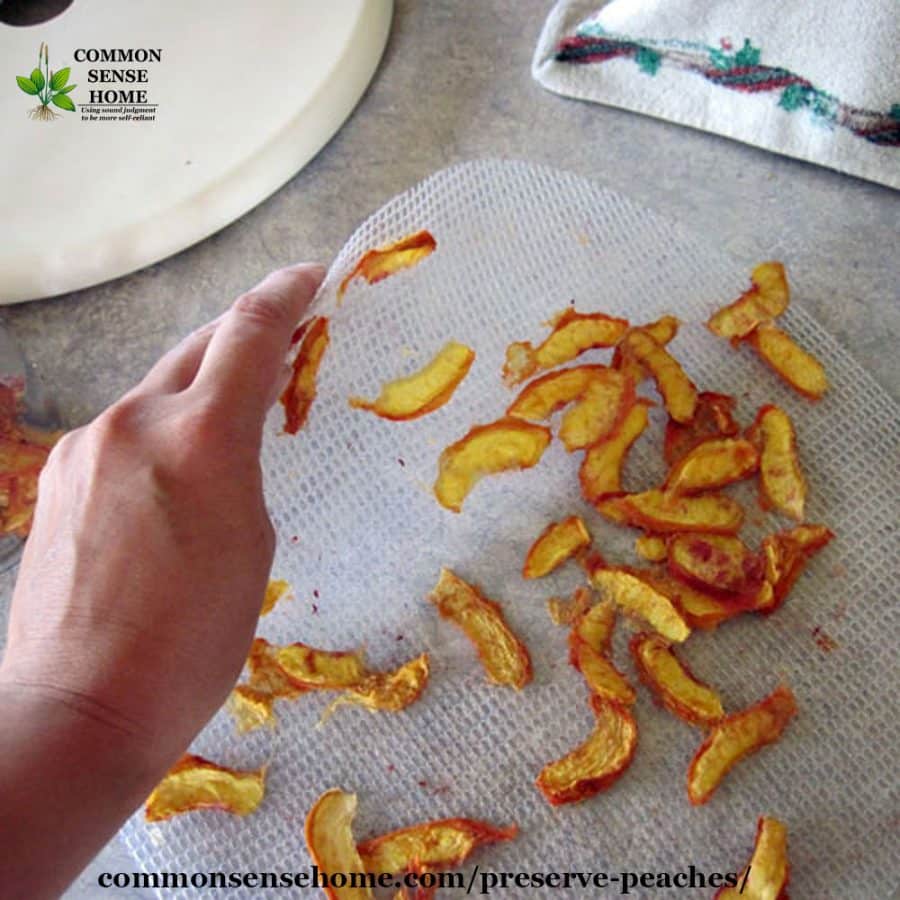
Store in an airtight container out of direct sunlight. If I have a lot of a particular dried fruit, I vacuum seal it in mason jars with the vacuum sealer attachment.
These make great snacks and can also be added to homemade granola or fruit and nut mixes.
If you've got a LOT of dried fruit, Mary Bell's Dehydrator cookbook has some good recipes for pies and other baked goods using dried fruit.
Freezing Peaches
Freezing is one of the simplest way to preserve peaches. As with the other methods, I start by peeling my peaches. After peeling, I slice them and dip them in acidified water to prevent browning. Drain well.
Spread peaches in a single layer on a baking sheet covered with a silicon mat or reusable parchment paper. Freeze several hours or overnight.
Pack the frozen slices into freezer containers, or vacuum seal for best storage.
Freezing on trays before packaging makes it easy to take a little or a lot of peaches from a package when you are ready to use them.
Peach Jam Recipes
I enjoy making low sugar peach jam with Pomona's Pectin. Peach jam is wonderful on toast, Brie cheese or ice cream.
You can find my favorite recipes here:
Peach Jam Two Ways – Peach Vanilla and Fuzzy Navel
“Blushing” Peach Jam (Peach-Raspberry Jam)

Preserve Peaches – Freeze Dry Peaches
Peaches are our favorite food to date from our Harvest Right home freeze dryer – pure ambrosia. Everything we've dried has been good (although I wouldn't do breakfast sausage again), but the peaches are exceptional.
Properly stored freeze dried products can be stored up to 25 years. This is hands down the best long term storage option to preserve peaches.
Freeze dried peaches melt in your mouth with intense peachy goodness. They rehydrate with a texture that is very similar to fresh peaches.
To freeze dry peaches, peel, slice, dip and drain as you would for dehydrating. Place in a single layer on freeze dryer trays, preferably lined with reusable parchment paper.
Process in freeze dryer until completely dry (there should be no cold spots in the center of the slices). Peaches are high moisture and high sugar, so the cycle will likely take over 24 hours. Store in a vacuum sealed mason jar or Mylar pouch with oxygen absorbers.
So there you go! Lots of ways to preserve peaches to enjoy all year long. If you've enjoyed this post, please consider Sharing or Pinning.
You may also enjoy:
- 12 Ways to Preserve Strawberries – Plus Tips to Keep Berries Fresh Longer
- Preserve Apples for Year Round Use 17 Easy and Creative Ways
- 25+ Asparagus Recipes + 4 Ways to Store Asparagus

Originally published in 2011, last updated in 2019.






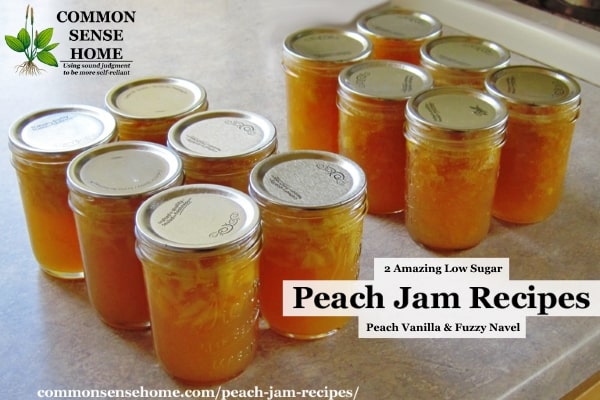

Aloha. I love canning peaches and your post here is my go-to refresher every year before I commence. This year I have put up 48 quarts so far. I think I will stop there and move on to tomatoes. We live in Alaska and bring our produce up from Washington state for canning. We go to quite a bit of work to do that, so it’s nice to have a resource to go to where I know I will get the straight skinny and end up with the best possible outcome. I really appreciate the information sharing. Thanks!
Thank you for your kind words. Living in Wisconsin, we stock up for long winters, too, though thankfully we’re able to source some of our produce a little closer. Peaches we still bring in from out of state, at least until we can persuade our little peach tree to be more productive. It’s not too happy with the weather around here.
Just came across this post after trying to figure out what to do with my upcoming peach harvest. In today’s economy, I want to use up every thing I grow without it going to waste. I appreciate the multiple ideas! Planning ahead is definitely key here. Thank you!!
Do I process quarts and pints the same length of time in the canner (meaning I could process some jars of each at the same time)?
As noted in the article, pints only need 20 minutes of processing, while quarts need 25.
If you really wanted to put both sizes in the canner together, opt for the longer processing time.
This is wonderfully informative and makes the canning seem sho much easier! One question before I start though: Do you wash peaches (gently rubbing the fuzz off) before doing anything like blanching?
Thank you for the video!
We normally don’t wash before blanching, as the fruit normally gets washed before it is packed for shipping. The blanching water and cooling water provide further rinses.
Love this page! Thank you for the information and recipes! Am aiming to make some jam.
I want to share an option for peeling the peaches that i CANNOT and DO NOT take credit for – I saw it in a YouTube video, and I think due credit goes to “Indigo Nili” – I am just sharing the concept, because it worked like I’ve never seen before!
Use your Instant Pot if you have one. Her video is quick, yet very informative.
If it doesn’t, do a YouTube search for “Indigo Nili – Peeling Peaches”. Read the comments for some pointers, but I think she’s a genius! Happy peaching!!
I watched the video and read through the comments, and I don’t see any advantage to using the Instant Pot – unless you’re determined to use the Instant Pot. Several people commented that the Instant Pot steaming made their peaches mushy. With the boiling water dip, I can do batch after batch of peaches, without waiting for the instant pot to get up to pressure or allowing it to vent.
I would like to peel the peaches (7.58 lbs), vacuum seal, then freeze them for later use for pie or cobbler. What is acidified water, and how do I make it or where do I buy it? Everyone here tells me here to just throw a lot of sugar on them, put them in the bag, & seal them. I don’t want to do that.
Hi Suzanne, as mentioned in the post, use roughly 2 tablespoons lemon juice or 1 teaspoon citric acid per gallon of water. Easy peasy. You could use vinegar if you didn’t have lemon, but it would give the peaches a hint of vinegar flavor.
I’ll modify the post to see if I can make that a little more clear.
Question: light sugar syrup recipe- how many peaches will I need for this recipe? And quart jar yield? 2 1/2 cups of sugar and 5 1/4 cups water
Estimate around 2 to 3 pounds of peaches per quart. Exactly how many jars this will fill depends on the size of the peaches and how you slice them.
I make pie filling from frozen peaches ,but I was told that it is not a good idea.. I would like to know why. I use clear gel and put my peaches in the pan , then put into jars .
There are a couple of different issues.
One – if you freeze the peaches first, then can them, I would expect the texture to get quite soft. Many people prefer firmer pieces of peach.
The second, and more important issue from a food safety perspective, is the potential for uneven heating. If you’re packing half frozen peaches in a hot syrup, you’re likely to have hot and cold spots in the jar. A cold spot in the wrong spot could also cause a jar to shatter.
Ideally, you want the contents of any any jar to be evenly heated all the way through, held at the proper temp for the proper amount of time.
As you’ve no doubt discovered because you’re still here to ask the question, acidic fruit with sugar syrup is forgiving. The acid in the fruit inhibits spoilage, as does the sugar in the syrup. (The sugar binds up free water, which bacteria need to grow.)
Can u do frozen sliced peaches in jars?
It is safe to freeze peaches in jars. I recommend wide mouth jars (some commercial canning jars will be labeled “for canning or freezer”) to make it easier to get the food out.
You can freeze the slices on a baking sheet and then pack them in jars, or pack them directly in jars.
Because there’s no way to easily remove the air from the jars (unless you want to try and vacuum seal them), they may not keep quite as well as those that are vacuum sealed. Handling chilled glassware always makes me a bit nervous due to slippery hands and such.
Some people choose to pack peaches in a light syrup before freezing to help prevent freezer burn.
I love peaches so much, even though they are hard to find where I live. Whenever I do find them, I dehydrate some of using in homemade oatmeal and I have canned them before as well. I’d love to be able to freeze-dry them, but that will have to wait until we have a freeze dryer. I’m really hoping to make peach jam this year – it just all depends on if I can get my hands on some good peaches or not. I used to love watching my grandparents put up peaches for the year, they froze most of them, but watching them work in the kitchen for hours and knowing we would have peached all winter long is one of my fondest memories.
Having a taste of home preserved fruit when the snow is flying brings a little taste of summer to warm a chilly day.
Thanks for sharing your memories.
Hi, It’s Marilyn from Alaska. I’m just jarring up my first batch of peaches ever. I appreciate your directions. they were really helpful, and I think the peaches are going to turn out well. I’ll be taking them out of the water bath in about five minutes. Looking forward to tasting summer, all through the winter! Thanks.
I just discovered your site and love your easy and detailed directions. I do have a couple of questions though so I get it right. I am going to can peaches and I was wondering if I’m doing a bushel do I blanch, peel,etc. all at once and then move on to the canning process while they sit in the water or how should I break it down? Also what is the best way to pit them so they look as pretty as yours without leaving any roughness in the middle? I canned some several years ago and while very tasty they were not pretty. Thanks for any help you can give me!!
It’s funny you should mention this, Polly, because I just had a discussion with my husband about how we should tackle processing a large number of pears.
Before I touch the fruit, I prep everything else in the kitchen. Once you start blanching, that clock is ticking for the fruit discoloring and/or softening as it sits and waits for canning.
To get the pits out cleanly, you want to make sure to look for “freestone” peaches, which as the name implies, have a pit (stone) that comes out freely and easily. Some peaches are clingstone types, and it’s a challenge to get the pit out at all. It’s not a problem if you’re eating them fresh and can nibble around the pit, but for canning, it makes a mess.
With the freestone peaches, there’s a sweet spot in the ripening process where the peaches are firm enough to hold their shape when being processed, but ripe enough that the pit comes out easily. Too ripe, and the pit will come out but the fruit will mush. Not ripe enough, and the pit sticks. As you work more with peaches you’ll get a better feel for when they are “just right”.
I wish I had seen this before I used my dehydrator for the first time drying peaches – they did indeed stick, but are they ever GOOD! I am definitely going to invest in the mesh sheets as I plan to do apples as well. I am eager to try your peach jam recipes as well. Thank you!
Enjoy your peaches. 🙂
I love the pics of your boys then and now! Many hands make light work and it’s so cool to see that they are still helping! also neat to see them “growed up”.
Thank you for your kind words, Toni. The house rule is that if you are under our roof, you help out any way you can, so as long as they are at home, no matter what size, they lend a hand. Over the years They’ve become quite helpful – many hands do indeed make light work.
Perfect timing for me! Peaches getting soft on my counter and I hadn’t thought about dehydrating!
I like freeze drying even better, but dehydrating is pretty tasty, too.
Freeze-dryer is very expensive, right? Can’t swing that, but would love to!
Yes, freeze dryers have come down in price, but are still a big investment. If there’s room in the budget, though, the quality of the home freeze dried food is amazing.
I live at 7000 ft. What adjustments do I need to make with boiling times?
Increase processing time by 15 minutes for water bath canning.
I want to thank you for such an informative web site. I’ve just recently been diagnosed with a disability and am no longer working. I started looking into ways of saving my food. I have made trips to the local food banks, and find that some of the foods are out of date. After becoming very discouraged and having a very limited income, I hit the web sites looking for ways to save my vegetables that I have bought at the grocery store. You see, sometimes I can’t get around to cook and wind up losing a lot of veggies due to ruining before I get to a point of cooking. I’m pretty picky on what vegetables I eat and when I find that they have ruined, I buy less because of the money that was wasted. I do can and make my own jellies and jams and want to do so much more. After doing a lot of research I’ve decided to try dehydrating the vegetables and other things, in order not to waist food. This site, so far, has been the best and easiest to understand so much more than other sites. Thank you so much.
You’re welcome. I’m glad that you’ve found the site helpful. Just so you know, many prepackaged foods are edible well past the date on the package, it’s just that quality decreases slowly over time. As long as the seal is intact and the food looks and smells fine once opened, you’re good to go.
What is the ratio for the lemon water for the dehydrating? Thanks.
I never measure. Maybe 1/4 cup per gallon of water? It doesn’t take a very large amount.
Also do you have a recipe for canning peach pie filling without pectin/anything artificial?
I usually just preserve the fruit and then use it to make the filling when I need it. With frozen fruit you thaw part way and use the same as fresh, with canned you just add some thickening. The peach pie filling recipes that are now recommended typically use ClearJel, which is a very refined corn starch, which doesn’t clump during canning. If you want a filling, you must add a thickener, and pectin and ClearJel are the ones that are safe for canning.
Hi! I love your sight! How long do the peaches last in the pantry?
The peaches should easily last two years with minimal change in coloration or consistency. I’ve read about people eating 20 year old canned food with the seals intact, but I’d be hesitant to go past 5 years.
Great tips. You’ve got handsome helpers there!
They are much taller now, but still pretty good help in the kitchen. Dunc commented yesterday that he figured it would be a good batch this year, because we caught the peaches when they were still pretty firm for canning.
I just discovered your information and am glad to know I’ve got a couple of other ways to preserve our peach crop this year. I don’t can peaches, but freeze halves in mason jars (after vacuum sealing). This year (thanks to you) I’m dehydrating some peaches, and may make some jam. Thanks!!!
The peach jams are wonderful! I’m sure you’ll enjoy them.
Allison – did you follow the link for the jam? I didn't include as many photos for that, but basically I just used these peaches (the ones that were softer), and chopped them up a bit by hand. They cook down fast as you heat them for jam, so I left them in roughly 1/4 to 1/2 inch square chunks.
webbsway – so true at the grocery store, and I'm afraid prices are just going to keep going up.
The boys are good helpers, and I figure it's important that they know where their food comes from, unlike so many people nowadays.
dr momi – Mixed feeling on the Tattler lids. This is my first year using them. I miss the "pink", but they do seem to work. Will be glad to see the results of the study.
Jenny – dehydrating and freezing are certainly quicker.
I just canned peaches and I wish I would have thought about doing what you did with the skins. For some reason, I peeled them all….BY HAND! Agh!
I would be interested to see how you did your jam; I made Peach Butter but I tried one batch with skins on to then go into a KA Fruit Strainer but it basically juiced them :/
Dried peaches are my favorite, so we usually stick to that or to freezing.
Love the picture of your "child labor"
:-)….and love your canning habits! Don't you love those tattler lids? I do! I hear the state of Wisconsin got a grant to study them.
O You know I have enjoyed this post! It is down right inspirational-since I have just come from the grocery store in shock as I passed it item on my list and not enough money to go around to start with – so I kept saying -no way!
Plus, I totally love your "slave-labor"! LOL
They are just too cute ! I think they are real keepers! : )